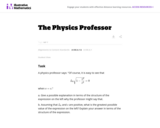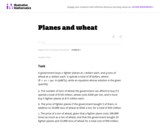
Detailed math tutorial features notes and examples that discuss methods for solving equations that contain exponentials.
- Subject:
- Mathematics
- Material Type:
- Reading
- Author:
- Paul Dawkins
- Date Added:
- 12/01/2023

Detailed math tutorial features notes and examples that discuss methods for solving equations that contain exponentials.

Detailed math tutorial features notes and examples that take a look at some methods for solving equations that contain logarithms.

Detailed math tutorial features notes and examples that take a look at symmetry, discussing symmetry about the x-axis, y-axis, and the origin. Shows methods for testing the symmetry of a graph.

Detailed math tutorial features definitions and examples that take a look at relations and functions, function notation, the domain and range of a function, and piecewise functions.

Detailed math tutorial features notes and examples that take a look at vertical and horizontal shifts of graphs as well as reflections of graphs about the x and y-axis, often called transformations.

Detailed tutorial features notes and numerous examples that illustrate how to graph rational functions.

This simple conceptual task focuses on what it means for a number to be a solution to an equation, rather than on the process of solving equations.

This task requires students to answer questions about the structure of an expression.

This is a simple exercise in creating equations from a situation with many variables. By giving three different scenarios, the problem requires students to keep going back to the definitions of the variables, thus emphasizing the importance of defining variables when you write an equation. In order to reinforce this aspect of the problem, the variables have not been given names that remind the student of what they stand for. The emphasis here is on setting up equations, not solving them.

Learn how to plot a simple inequality on a number line. The example used in this video is x < 4. [1:34]
Khan Academy learning modules include a Community space where users can ask questions and seek help from community members. Educators should consult with their Technology administrators to determine the use of Khan Academy learning modules in their classroom. Please review materials from external sites before sharing with students.

To plot an inequality, such as x>3, on a number line, first draw a circle over the number (e.g., 3). Then if the sign includes equal to (≥ or ≤), fill in the circle. If the sign does not include equal to (> or <), leave the circle unfilled in. Finally, draw a line going from the circle in the direction of the numbers that make the inequality true.
Khan Academy learning modules include a Community space where users can ask questions and seek help from community members. Educators should consult with their Technology administrators to determine the use of Khan Academy learning modules in their classroom. Please review materials from external sites before sharing with students.
![Pre-Calculus Notes: The Fundamental Theorem of Algebra (FTA) [PDF]](https://openspace.infohio.org/static/newdesign/images/materials/default-thumbnail-index.png)
Learners examine the fundamental theorem of algebra. The resource investigates the linear factorization theorem, Descartes?s rule of signs, and rules for zeros.

Students revisit the fundamental theorem of algebra as they explore complex roots of polynomial functions. They use polynomial identities, the binomial theorem, and Pascals Triangle to find roots of polynomials and roots of unity. Students compare and create different representations of functions while studying function composition, graphing functions, and finding inverse functions.
Find the rest of the EngageNY Mathematics resources at https://archive.org/details/engageny-mathematics.

This module revisits trigonometry that was introduced in Geometry and Algebra II, uniting and further expanding the ideas of right triangle trigonometry and the unit circle. New tools are introduced for solving geometric and modeling problems through the power of trigonometry. Students explore sine, cosine, and tangent functions and their periodicity, derive formulas for triangles that are not right, and study the graphs of trigonometric functions and their inverses.

(Nota: Esta es una traducción de un recurso educativo abierto creado por el Departamento de Educación del Estado de Nueva York (NYSED) como parte del proyecto "EngageNY" en 2013. Aunque el recurso real fue traducido por personas, la siguiente descripción se tradujo del inglés original usando Google Translate para ayudar a los usuarios potenciales a decidir si se adapta a sus necesidades y puede contener errores gramaticales o lingüísticos. La descripción original en inglés también se proporciona a continuación.)
Los estudiantes vuelven a visitar el teorema fundamental del álgebra mientras exploran raíces complejas de funciones polinomiales. Utilizan identidades polinomiales, el teorema binomial y el triángulo de Pascal para encontrar raíces de polinomios y raíces de la unidad. Los estudiantes comparan y crean diferentes representaciones de funciones mientras estudian composición de funciones, gráficos de funciones y encuentran funciones inversas.
Encuentre el resto de los recursos matemáticos de Engageny en https://archive.org/details/engageny-mathematics.
English Description:
Students revisit the fundamental theorem of algebra as they explore complex roots of polynomial functions. They use polynomial identities, the binomial theorem, and Pascals Triangle to find roots of polynomials and roots of unity. Students compare and create different representations of functions while studying function composition, graphing functions, and finding inverse functions.
Find the rest of the EngageNY Mathematics resources at https://archive.org/details/engageny-mathematics.

(Nota: Esta es una traducción de un recurso educativo abierto creado por el Departamento de Educación del Estado de Nueva York (NYSED) como parte del proyecto "EngageNY" en 2013. Aunque el recurso real fue traducido por personas, la siguiente descripción se tradujo del inglés original usando Google Translate para ayudar a los usuarios potenciales a decidir si se adapta a sus necesidades y puede contener errores gramaticales o lingüísticos. La descripción original en inglés también se proporciona a continuación.)
Este módulo revisa la trigonometría que se introdujo en la geometría y el álgebra II, uniendo y ampliando aún más las ideas de la trigonometría del triángulo recto y el círculo unitario. Se introducen nuevas herramientas para resolver problemas geométricos y de modelado a través del poder de la trigonometría. Los estudiantes exploran funciones sinuso, coseno y tangentes y su periodicidad, derivan fórmulas para triángulos que no son correctos y estudian los gráficos de las funciones trigonométricas y sus inversos.
English Description:
This module revisits trigonometry that was introduced in Geometry and Algebra II, uniting and further expanding the ideas of right triangle trigonometry and the unit circle. New tools are introduced for solving geometric and modeling problems through the power of trigonometry. Students explore sine, cosine, and tangent functions and their periodicity, derive formulas for triangles that are not right, and study the graphs of trigonometric functions and their inverses.

This 15-minute video lesson gives an example involving the preimage of a set under a transformation. It also gives a definition of kernel of a transformation.
Khan Academy learning modules include a Community space where users can ask questions and seek help from community members. Educators should consult with their Technology administrators to determine the use of Khan Academy learning modules in their classroom. Please review materials from external sites before sharing with students.

This task compares the usefulness of different forms of a quadratic expression. Students have to choose which form most easily provides information about the maximum value, the zeros and the vertical intercept of a quadratic expression in the context of a real world situation. Rather than just manipulating one form into the other, students can make sense out of the structure of the expressions.

This question provides students with an opportunity to see expressions as constructed out of a sequence of operations: first taking the square root of n, then dividing the result of that operation into s. Students studying statistics encounter the expression in this question as the standard deviation of a sampling distribution with samples of size n when the distribution from which the sample is taken has standard deviation s.

Do you need practice learning and remembering algebra vocabulary terms? This concentration game is the web site for you! There is a link to a list of terms with definitions you can click if you want to see if you are correct.